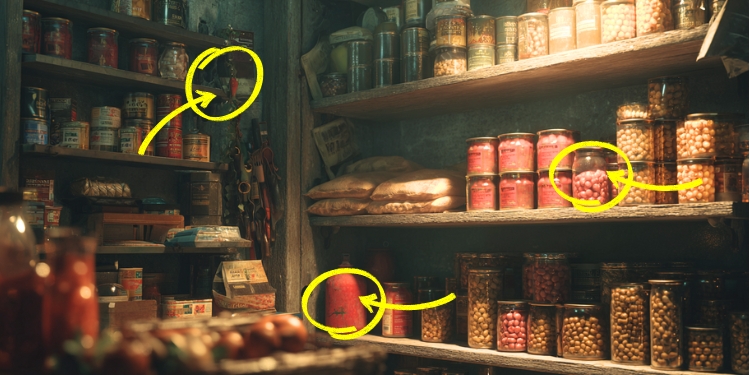How I Found Out My Grandpa Was A Prepper
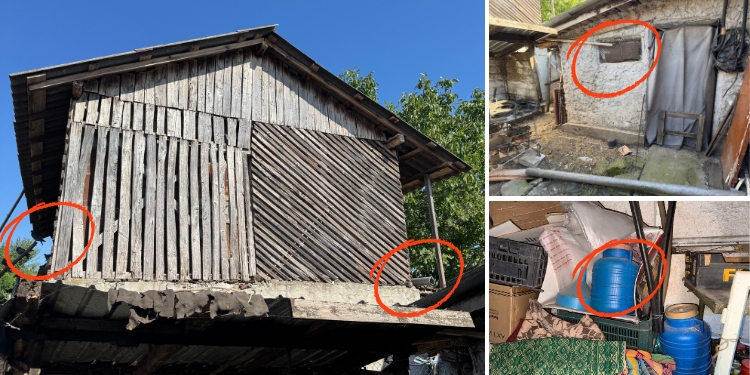
I had a wonderful childhood. I could never truly put into words how beautiful it was to spend my days (especially those long summer ones) in the company of my grandparents. Mom and dad were always very busy, so it was my grandparents who shaped me the most during those early years of life.
Time passed, though, and almost without noticing, I found myself a grown man. With a wife, kids, and aging parents. With problems, struggles, and constant worries about an uncertain future. In fact, it was those very worries that pushed me into becoming a prepper. Still, the years didn’t just pass for me.
First, grandma was gone, at the age of 80. Not long after, my grandfather followed. My role model of masculinity, my example of resilience… When my grandfather passed away, I couldn’t bring myself to visit his old house for years. The memories were too raw.
But the day I finally stepped inside, I discovered something that changed the way I look at survival forever: my grandpa was a prepper. Stick with me and I’ll show you how I came to that conclusion and the powerful lessons I learned from him.
The First Signs
One weekend, just a few weeks after my grandfather had passed, I finally gathered the courage to take my family back to the old house. I hadn’t set foot there in many years. The place looked exactly as you’d expect after years of wind, rain, and minimal maintenance.
The old shed’s walls showed weathering and the yard had grown wild with weeds, but something caught my eye immediately. What those worn boards and weathered doors revealed became my first real clue into grandpa’s mindset: he built everything to outlast whatever crisis might come.
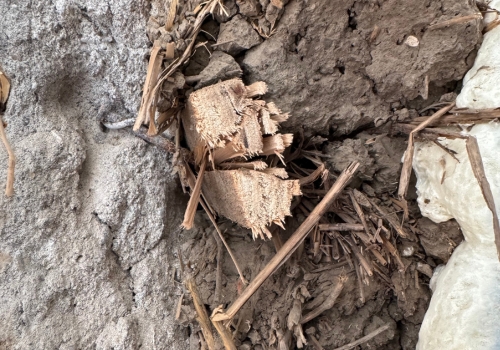
Standing there, I realized how much wisdom was embedded in his approach to self-reliance. If you’re looking to build that same level of preparedness into your own life, this book shows you exactly how to create essential systems that work when everything else fails—just like grandpa’s structures that still stood strong after all those years.
Even decades later, his construction choices spoke of a man who planned beyond the next pay-check. He planned for the next generation. That’s when I understood the true value of creating a completely self-sufficient setup on your property.
Built to Last
When I examined the shed walls closely, I found something that would make any modern prepper nod in approval. Grandpa had rejected flimsy modern materials entirely. Instead, he’d crafted these walls from clay and straw—materials he could source right from his own land—then sealed everything with homemade plaster.
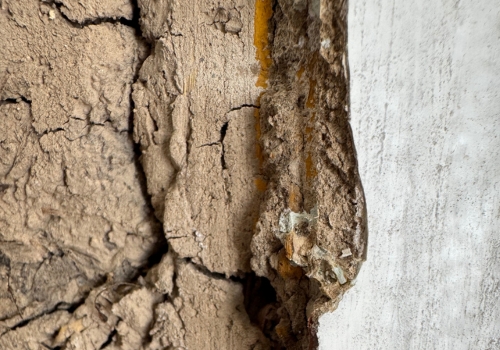
Decades had passed, and while the surface showed cracks and peeling in places, the core structure remained rock-solid. This wasn’t some weekend DIY project meant to last until the next home improvement trend.
Grandpa had engineered this for the long haul, using techniques that allowed easy repairs with materials any rural property owner could gather or make themselves.
Here stood my first concrete proof that grandpa thought like a true prepper. He didn’t trust mass-produced solutions that would fail when supply chains broke down. He built with nature’s materials, planned for permanence, and designed for field repairs.
Even in something as simple as a shed wall, I could see his survival philosophy: make it strong, make it last, and make sure you can fix it yourself when the hardware store isn’t an option.
The Workshop of a Survivor
If the shed walls proved grandpa built for permanence, his workshop revealed an even more crucial prepper truth: he’d achieved complete mechanical independence.
Corrugated metal tiles covered the ceiling—practical, bulletproof, and nearly maintenance-free for decades.
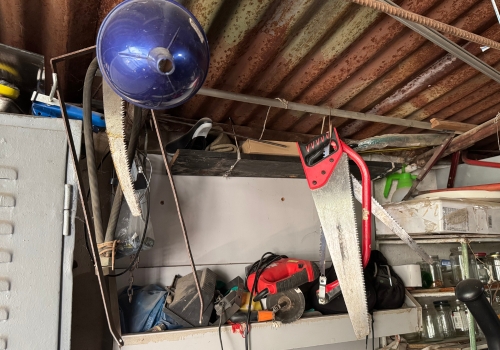
Below, a massive three-compartment metal cabinet dominated the space, built to military specifications and designed to outlast several lifetimes.
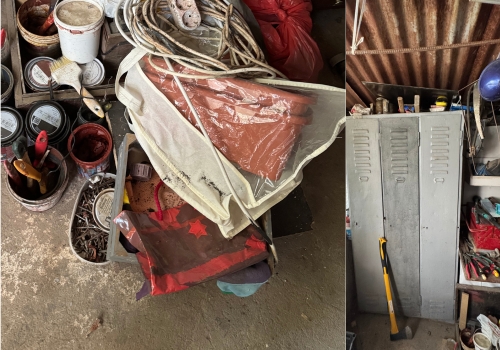
I inventoried the contents like I was cataloging survival gear: extension cords for electrical work, an angle grinder for metal fabrication, precision pliers, multiple screwdrivers, hammers for construction, a splitting axe for firewood, and a sharp handsaw for lumber work.
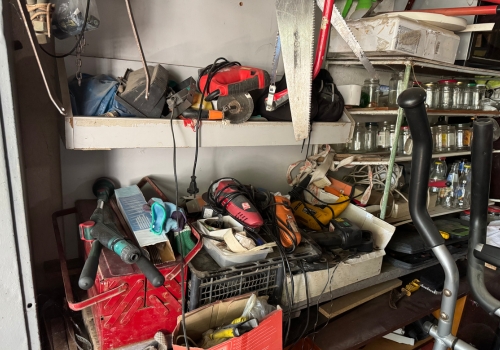
Paint cans lined the shelves alongside glass jars sorted by fastener type. Every nail, screw, and bolt organized for instant access. Stacks of seasoned wood pieces waited nearby for the next repair project.
Most people would dismiss this as an old man’s cluttered workspace. I recognized it as a complete self-reliance system. Grandpa never waited for repair services or hardware store hours. He maintained the tools and materials to solve any problem immediately, using his own hands and skills.
This embodies core prepper philosophy: redundant tools, forward-thinking material stockpiles, and the expertise to transform scraps into solutions. When supply chains collapse and service calls become impossible, a workshop like grandpa’s transforms from hobby space into survival headquarters.
But having the tools and materials is only half the equation. The other half is knowing how to secure your home, stretch your food supplies, and maintain the mental fortitude to lead your family through extended crisis periods.
That’s where A Navy SEAL’s Bug-In Guide becomes invaluable (at least for me)—it teaches you the tactical mindset and practical skills for food stockpiling, home defense, strategic meal planning, and building the mental resilience that separates survivors from victims when you’re forced to hunker down and wait out the storm.
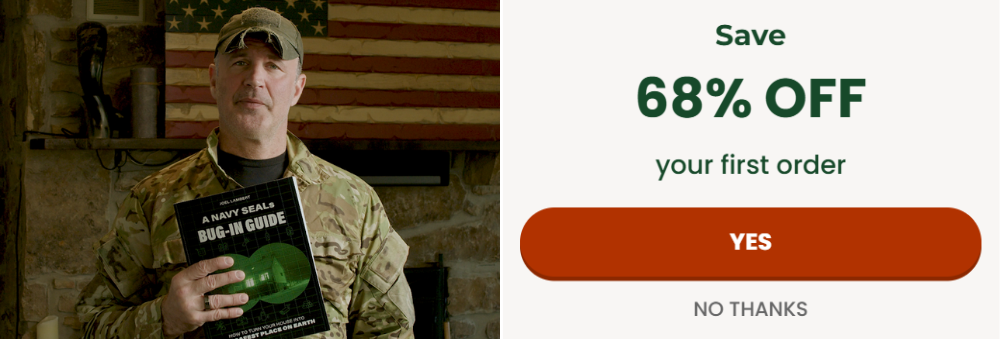
The Cellar
Now for the crown jewel of grandpa’s prepping operation. He’d constructed this cellar using the same clay-and-plaster technique as the shed. Traditional methods designed to preserve food for generations without electricity or modern refrigeration.
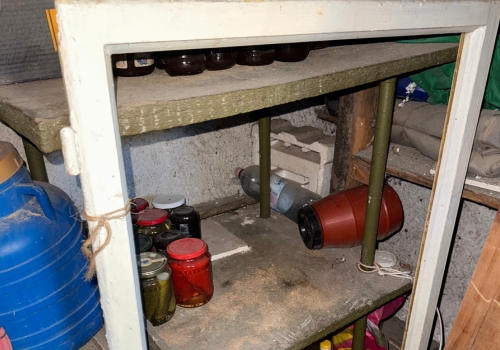
The shelves displayed what looked like a professional food preservation operation: rows of sealed mason jars containing pickled vegetables, tomato juice, and preserved fruits, all maintaining their color and integrity after years of storage. He used honey to preserve foods because he knew its high sugar content prevents bacteria from growing.
He buried onions in sand because he knew it could absorb moisture and prevent onions from sprouting or rotting. Most of these techniques have been lost to history, but you can still find the most important ones in The Lost Superfoods book.
A rusty padlock secured one corner section—clearly his most valuable supplies.
Water-resistant gear filled the remaining spaces: quality hoses, metal funnels, and protective clothing.
Large blue barrels occupied strategic positions, obviously intended for bulk water or grain storage. The centerpiece caught my attention immediately: a wooden cask housing a metal container with an attached spigot.
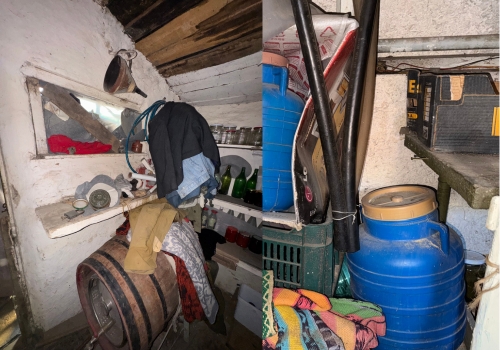
Based on the underground location and professional setup, I believe grandpa used this for long-term water storage, keeping his family’s most critical resource cool, protected, and accessible.
As you can see, he never stored his water stockpile next to a fence. That’s because wooden fences, treated posts, or even painted metal fences can leach chemicals into nearby soil and containers when it rains. Over time, that can contaminate water stored in plastic or metal barrels.
Another reason is that fences also tend to attract pests looking for shade and shelter, which can chew through or infest storage containers. Lastly, a water stockpile placed against a fence is easy to spot from outside, making it vulnerable to thieves or looters.
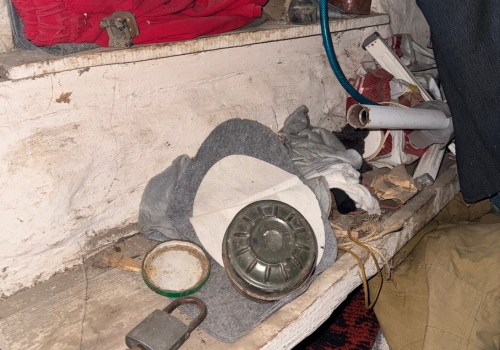
The setup impressed me not just for its contents, but for its underlying strategy. Grandpa understood that grocery stores and modern distribution systems represent fragile links in the survival chain. He’d invested in time-tested preservation methods: glass containers, wooden barrels, and underground storage that would function regardless of power grid status.
This cellar provided genuine insurance against food shortages, supply disruptions, and economic collapse.
Interestingly, the cellar’s structure reminded me very much of what I managed to assemble at my own home.
I created an underground bunker where I keep my most important supplies. Why underground?
Because, just like grandpa, I wanted to have a proper space for food provisions and other objects I might need, but also a place where I could take shelter in case SHTF.
I’ve been using this space for 5 years now, and it was excellent even during COVID times. I stored all my provisions there, also gaining space in the house.
I assembled it myself and it cost me around $400, including the materials and the plans I bought from here.
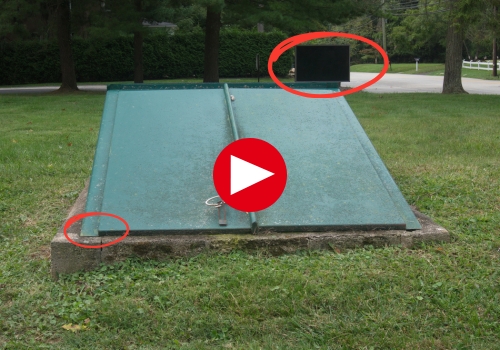
The Livestock Operation
The final piece of grandpa’s survival puzzle triggered a flood of childhood memories. I remembered how seriously my grandparents managed their chicken flock. Gosh, these birds weren’t pets or a hobby…
They formed the backbone of the family’s protein security, delivering fresh eggs daily and meat when needed.
Walking through the backyard, I rediscovered their chicken shelter. Grandpa had welded a sturdy metal frame, now showing honest rust from decades of weather exposure.

He’d engineered the entire structure on legs, elevating it above the concrete pad. That was a deliberate design choice that protected his flock from ground moisture, predators, and disease transmission.
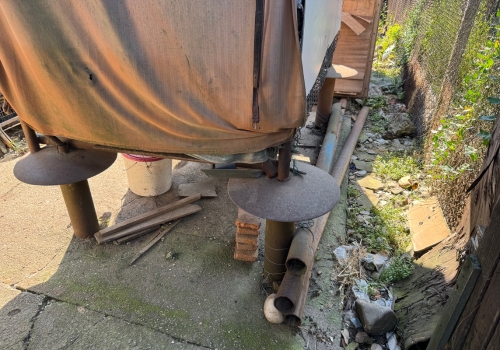
Time had weathered the frame and stripped away the paint, leaving the structure tired but intact. Even in decay, it demonstrated sound livestock management principles that many modern preppers would recognize and respect.
This simple shelter proved that my grandparents grasped what many Americans have forgotten: genuine food security starts in your own backyard. Those chickens represented their daily insurance policy against hunger and their living reminder that true independence comes with feathers, claws, and a steady supply of fresh protein.
The sight brought both warmth and regret. Decades had passed since those birds provided for the family, but the shelter stood as permanent proof that real survival depends on the practical, proven methods our grandparents practiced every single day.
I don’t want to be unfair and accuse all Americans of no longer using these methods. There are still preppers, homesteaders, and even entire communities of people who raise animals in their own backyard. Personally, I’ve always admired those in the Amish community…
They are true masters in raising chickens and preserving the eggs they can produce. Reading The Amish Ways Book, I was very impressed by the part that explains why the Amish keep eggs covered in salt.
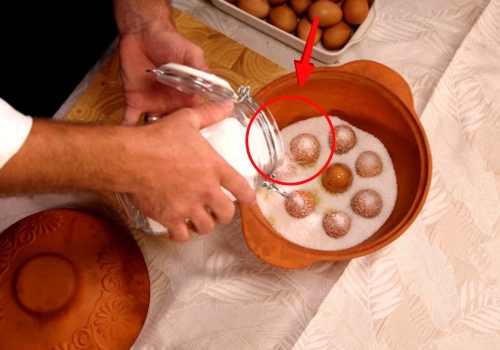
CLAIM SPECIAL DISCOUNT HERE
Final Thoughts
My grandparents survived genuine hardships. They endured wars, rationing, and shortages that most modern Americans can barely imagine. As a child, I spent countless hours exploring every corner of these spaces—the workshop, cellar, livestock areas, and surrounding land. But somewhere along the way, I lost sight of their lessons.
I forgot the practical wisdom my grandfather demonstrated every day, not through lectures, but through his deliberate choices about how to build, preserve, and prepare. Maybe I should have listened more carefully. Maybe I should have learned these skills while he could still teach them. But it’s never too late to honor his example.
Even after he’s gone, grandpa managed to show me what old-school American self-reliance actually looks like in practice. His methods weren’t complicated or expensive, but they were proven, practical, and sustainable.
For that lesson, I can only feel grateful. I’m grateful I finally returned to walk through those spaces again and rediscovered what I’d once forgotten.
And yes! That wooden barrel from his cellar will soon hold water in my own basement storage room. A piece of my grandfather’s self-reliant spirit will continue serving the next generation, exactly where it belongs.
I really appreciated that my grandparents were even interested in water stockpiling. But to be honest, my choice is a bit more modern… I decided to invest in the U.S. Military’s secret plans, specifically The Water Freedom System. Also, for bugging out, I recommend this extremely clever product called The Water Smart Box. Give both of them a try!
You may also like:

My Grandfather is a WWII Vet. Here is What He Taught Me!
Save Money You Pay on Medicine with This (Video)
15 Modern Laws That Would Get Our Grandfathers Arrested
How Your Grandfather Celebrated the 4th of July 100 Years Ago (1918)
Yesterday My Grandfather Died
Read the full article here




